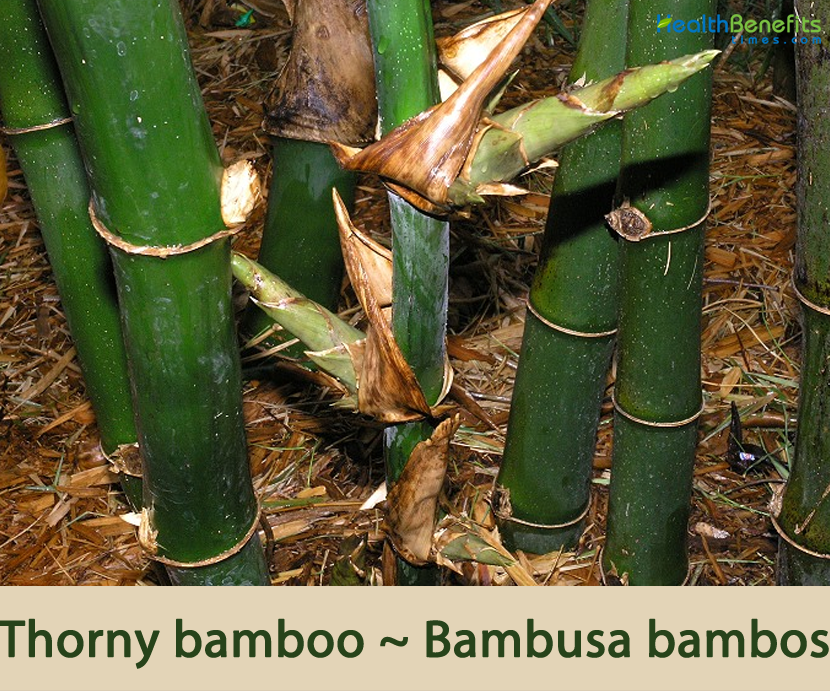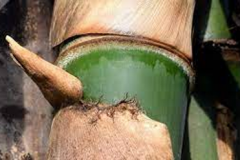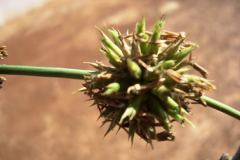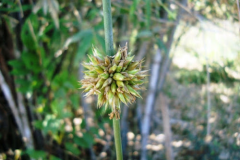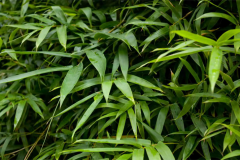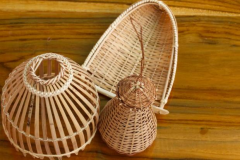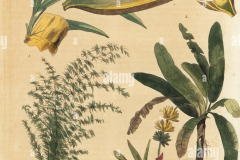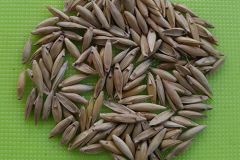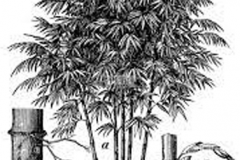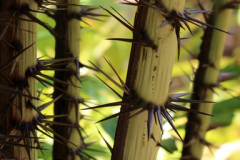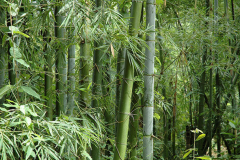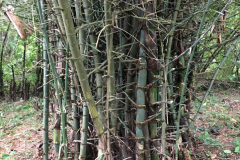| Thorny bamboo Quick Facts | |
|---|---|
| Name: | Thorny bamboo |
| Scientific Name: | Bambusa bambos |
| Origin | India, Southeastern Asia and Southern China |
| Taste | Astringent, sweet and bitter in taste |
| Major nutrients | Healing Power, Stomach Disorders, Respiratory Disorders, Menstrual Disorders, Intestinal Worms, Wounds and Ulcers |
| Name | Thorny bamboo |
|---|---|
| Scientific Name | Bambusa bambos |
| Native | India, Southeastern Asia and Southern China. It is now cultivated throughout the tropics, in Southeastern Asia and especially in East Java, Singapore, the Malaysian Peninsular, Thailand and the Philippines. It is also naturalized in Seychelles, Central America, West Indies, Malaysia and Maluku |
| Common Names | Indian thorny bamboo, Common bamboo, Giant thorny bamboo, Spiny bamboo, Thorny bamboo, Surinaamse bamboe, Yello bamboo |
| Name in Other Languages | Assamese: Bnah, jaati baansh (জাতি-বাঁহ), mokal baansh (মোকাল-বাঁহ) Bengali: Bans, Behar, baansha (বাঁশ) Burmese: Kya hkaat warr (ကြခတ်ဝါး) Cambodia: Russei khlei, russei prei Central Khmer: Ryssaeikhlei (ឫស្សីឃ្លៃ) Chinese: Ci zhu, Ci ce zhu, Yu zhu Cuba: Bambú espinoso English: Indian thorny bamboo, Giant thorny bamboo, Spiny bamboo, Thorny bamboo, male bamboo, spring bamboo French: Bambou Roseau, bambou épineux German: Bedornter Riesenbambus, Rohrbambus, dorniger Bambus, Bambus, Dorniger Gujarati: Baambu (બામ્બુ), vaans (વાંસ) Hindi: Bans, Kattang, baans (बांस), bambu (बम्बू), buns (बंस), bambu duri, baroowa, khare bans, kotoba Indonesia: Bambu duri Jammu: Lamberi Japanese: Shi chiku Kannada:, Hebbidiru (ಹೆಬ್ಬಿದಿರು), Biduru, Andebidiru, bidiru (ಬಿದಿರು), vamsha (ವಂಶ) Khmer: Rüssèi roliëk Konkani: Vaaso (वासो), vaso (वसो), velu (वेलु) Laotian: Phaix ba:nz Malayalam: Illi (ഇല്ലി), Kabu, Kaniyaram, Karmmaram, Mula (മുള), Muncha, Mungil, Pattil, Mungil, Mulla Manipuri: Saneibi (সনৈবী) Marathi: Bamboo (बांबू), kalaka (कळक), kalanka (कळंक), maanga (माणगा), velu (वेळू) Mizo: Raw-hling Myanmar: Kya-kat-wa Nepali: Kauns (काँस) Oriya: magar baans (ਮਗਰ ਬਾਂਸ) Philippines: Indian bamboo Portuguese: Bambu, Bambu-comum, Bambu-da-índia, Bambu-de-espinho, Bambu-espinoso, bambu-de-calcutá, bambu-vulgar Punjabi: Magar Bans Sanskrit: Amupah (आमुपः), ardrapatrakah (आर्द्रपत्रकः), kantakah (कण्टकः), kantakilah (कण्टकिलः), vambhah (वम्भः), vamsh (वंशः) Sinhalese: Kaṭu uṇa (කටු උණ) Spanish: Bambú, Cana espina, bambú espinoso, banbu cafia de indios Sundanese: Haur cucuk Swedish: Taggbambu Tamil: Mūṅkilarici (மூங்கிலிரிசி), kulay-munkil (குழாய்மூங்கில்), peru-munkil (பெருமூங்கில்) Telugu: Bongu-veduru (బొంగువెదురు), vamsamu (వంశము), veduru (వెదురు) Thai: Mai si suk, Phai si suk, phai-nam, phai-pa Urdu: Baans (بانس), bambu (بمبو), buns (نبس) Uttar Pradesh: Kanwas Vietnamese: Tre nghệ, Tre gai, Tre la nga |
| Plant Growth Habit | Large, evergreen, clumping, perennial grass |
| Growing Climates | Found most abundantly in mixed moist deciduous forest, and not so commonly in mixed dry deciduous forest and in semi-evergreen forest, growing best along river valleys and in other moist conditions, on hills |
| Soil | Prefers rich to medium fertile soils with a good water supply |
| Plant Size | Can be 30 meters or more tall and 15 – 18cm in diameter |
| Culms | Average diameter between 10-18 cm and are between 20-30 m tall (though the highest documented culm measured about 40 m). |
| Leaf | Small, linear-lanceolate with a long-pointed tip. Leaves are about 5-20 cm long and 1-3 cm wide with about 10 leaves in each pair |
| Propagation | By rhizome, culm and branch cuttings |
| Taste | Astringent, sweet and bitter in taste |
| Plant Parts Used | Root, stem, leaves, dried resin, tender shoot |
| Lifespan | 24-32 year |
| Health benefits |
|
| Culinary Uses |
|
| Precautions |
|
Plant Description
Thorny bamboo is a large, evergreen, clumping, perennial grass that normally grows about 30 meters or more tall and 15 – 18 cm in diameter. The plant is found most plentifully in mixed dry deciduous forest, in mixed moist deciduous forest, in semi-evergreen forest, along river valleys, in other moist conditions and on hills. The plant prefers rich to medium fertile soils with a good water supply. Rhizomes are usually short-necked. Stems are about 10 to 25 meters high and 8 to 15 centimeters in diameter. The basal parts are enclosed by stiff, branched, interlaced and spiny branches.
Culms
Fast growing, strong woody culms have an average diameter between 10-18 cm and are between 20-30 m tall (though the highest documented culm measured about 40 m). The internodes are dark green colored with very dense walls. Nodes are somewhat swollen and some lower nodes produce short floating roots.
Leaves
Leaves are small, linear-lanceolate with a long-pointed tip. Leaves are about 5-20 cm long and 1-3 cm wide with about 10 leaves in each pair. They are glaucous below, with small ligule and tiny auricles with few, upright, oral setae.
Seeds
The plant may flower from 16-52 years. Expansive flowering was last described in the early 90’s (1991-1995) where single clumps offer about 50-100 kg of seeds (70,000 to 85,000 seeds per kilogram). Seeds are usually practical for about 6-8 months.
History of Introduction and Spread
Bambusa species have been vigorously introduced all through tropical, subtropical, as well as temperate provinces of the world since the 19th century. The plant is mostly used to control erosion, fencing plants, and to make plantations so as to commercialize their culms. It has been presented to other Asian countries on a small scale, commonly due to seed availability rather than wanted species characteristics.
Health benefits of Thorny bamboo
Listed below are some of the well-known health benefits of Thorny bamboo
1. Healing Power
The leaves of bamboo tree are useful in dealing with irregular complaints, and arrest secretion or bleeding. They are also an effective aphrodisiac. Normally the leaves do not have noticeable taste.
2. Stomach Disorders
Leaves are useful in the treatment of stomach troubles. They are useful in strengthening the stomach and promoting its action. Young shoots are also beneficial for dealing with stomach disorders. In many parts of India, the leaves are used in the form of decoction to treat diarrhea.
3. Respiratory Disorders
Tender shoots are beneficial in the treatment of respiratory diseases. Decoction of the shoots is taken with a tablespoon of honey once or twice every day.
4. Menstrual Disorders
Decoction of the leaves helps to encourage menstruation. It promotes and controls the menstrual periods. Decoction of the nodes is also beneficial for this purpose.
5. Intestinal Worms
Leaves are useful in killing intestinal worms, particularly threadworms. They have to be taken in the form of decoction.
6. Wounds and Ulcers
Poultice of the tender shoots is used for cleaning wounds and maggot-infested wounds. Decoction or juice of the leaves is applied as a medication in such type of ulcers.
Traditional uses and benefits of Thorny bamboo
- Root is used for joint pain and general weakness and the leaves to strengthen stomach function.
- Young sprouts are used against indigestion, nausea and wound infection.
- Plant juice is used for osteoporosis and osteoarthritis.
- The plant is used in numerous ways in Ayurvedic medicine.
- Root is used to treat general debility and joint pain.
- Leaves are taken internally to encourage menstruation and to relieve period pain.
- Young sprouts are taken internally to relieve indigestion and nausea.
- They are applied externally to help drain infested injuries.
- Juice of the plant is taken internally for strengthening of cartilage during osteoarthritis and osteoporosis.
- Decoction of leaves helps to induce lochia after childbirth.
- Decoction of stems is applied externally for swollen joints.
- Bud of leaf is used in fevers, leprosy and hemoptysis.
- Decoction of roots is used for anuria.
- Leaves and stems are used for treatment of leucoderma, blood diseases, inflammations, biliousness, piles and wounds.
- Roots are applied to bleeding gums and ringworm.
- Decoction of shoots is taken for respirational disorders.
- Juice of flower is infused to ear to cure earache.
- Decoction of tender shoots is used as abortifacient in the first month and in the last month, to encourage labor, and to ease placental exclusion.
- Leaves are used in treatment of eye troubles, leprosy, hematemesis, amenorrhea, lumbago, hemorrhoids and dysmenorrhea.
- It is helpful in sustaining the reliability of the bones, nail, hair, skin, gums, teeth and arterial walls.
- It is used to ease psoriasis and eczema.
- Paste or ash of roots is used to cure ringworm infection, skin disorders, dermatoses and rabies.
- Fruits are suitable in fat metabolism as well as obesity.
- The Kani communities of India believe that the seeds improve fertility.
- An infusion made from the leaves is used to take bath for healing of measles in Mauritius.
Ayurvedic Uses of Thorny bamboo
- Root is made into paste and applied over the part affected with eczema, dark discoloration.
- Dried resin is made into powder and mixed with honey and used to treat cold, fever and cough.
- Decoction of the leaves in a dose of 40–50 ml is given to treat pain in abdomen during menstruation, dysmenorrhea, and to fortify the uterine muscles after delivery.
- Decoction of the root in a dose of 40–50 ml is used to treat adverse effect of dog bite and scorpion bite.
- Seed is made into edible food and given as regular diet for dealing with diabetes.
- Decoction of the tender leaves is given in a dose of 40–50 ml to cure intestinal worm infestation.
Other Facts
- It is used as food, medicine, and numerous other purposes.
- It is often grown as wind-breaks round farms.
- Leaves are used for thatching.
- It is planted along rivers to check floods.
- Stems are used for making furniture, scaffolding, paper, rafts and lots of other items.
- They are used to make the sails of ships, as well as their poles and ropes.
- Chairs, tables, mats, bedsteads, screens and bedding can be made from the stems.
- Household utensils, and rough underclothing, are also made of this material.
- Whole stems are used in the construction of bridges and water pipes.
- Pitchers, Buckets, cups and flasks are made from pieces of the stems.
- Chinese paper and ropes are made from the fibers in the stems.
- All kinds of agricultural implements, machines for spinning cotton are constructed from Thorny bamboo.
- Leaves are used for packing, as a filling for mattresses etc.
- It is the most popularly used species of bamboo in the Philippines.
- Leaf juice is used in aromatherapy.
- The plant takes 12 years to reach maturity.
- It may be used for reforestation and maintenance of eroding banks.
Prevention and Control
There are no management policies presently planned for the prevention and control of Thorny bamboo. Though, for the control of other species, it is suggested that all culms and stems should be detached using specialized equipment. Regrowth should be controlled using herbicides like glyphosate or amitrole.
References:
https://www.itis.gov/servlet/SingleRpt/SingleRpt?search_topic=TSN&search_value=193440#null
https://npgsweb.ars-grin.gov/gringlobal/taxon/taxonomydetail?id=403368
https://pfaf.org/user/Plant.aspx?LatinName=Bambusa+bambos
https://gd.eppo.int/taxon/BAMBM
https://indiabiodiversity.org/species/show/228834
http://www.theplantlist.org/tpl1.1/record/kew-398642
http://www.stuartxchange.com/Kauayan.html
https://www.feedipedia.org/node/496
https://www.flowersofindia.net/catalog/slides/Indian%20Thorny%20Bamboo.html
https://en.wikipedia.org/wiki/Bambusa_bambos
https://plants.usda.gov/home/plantProfile?symbol=BABA8


